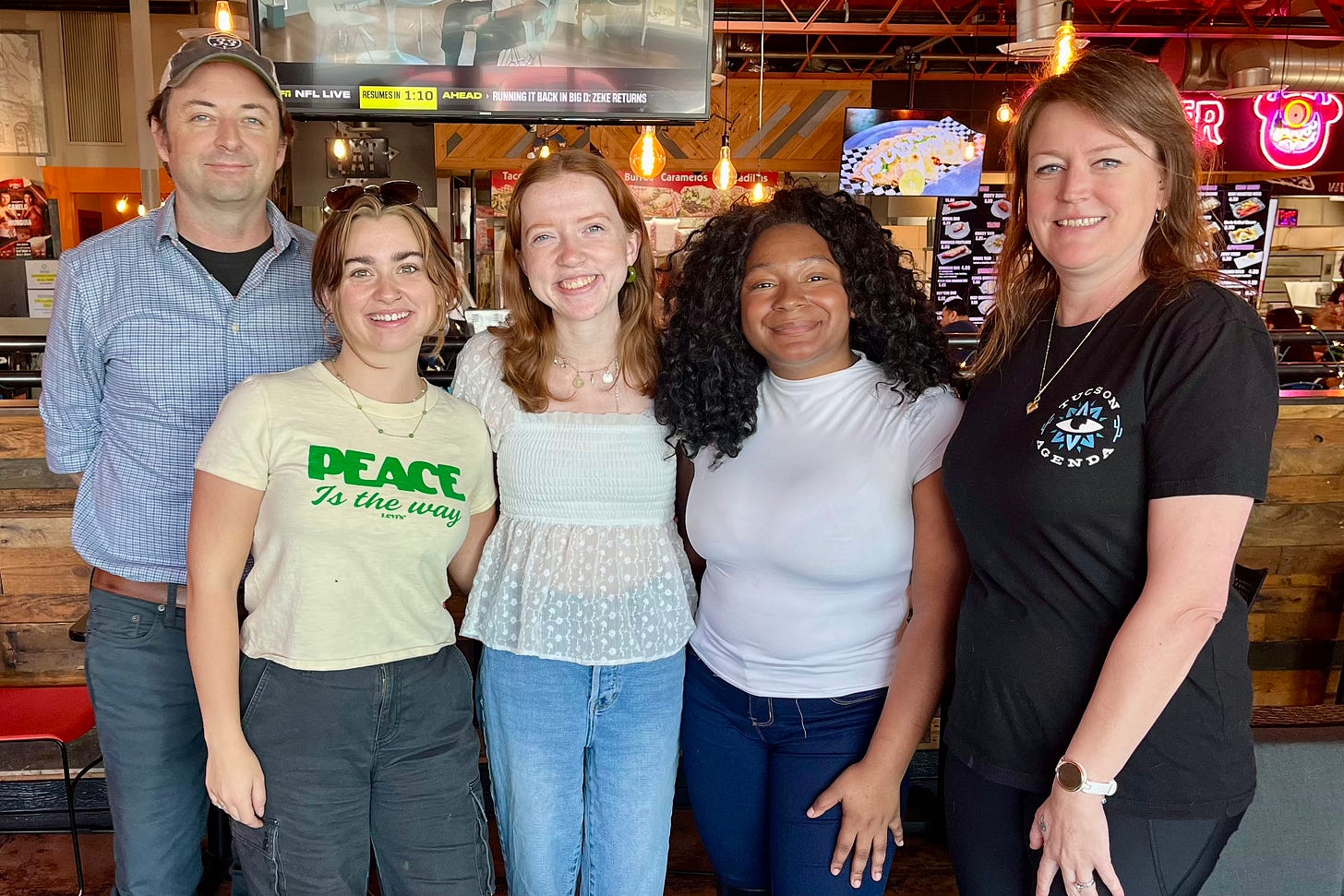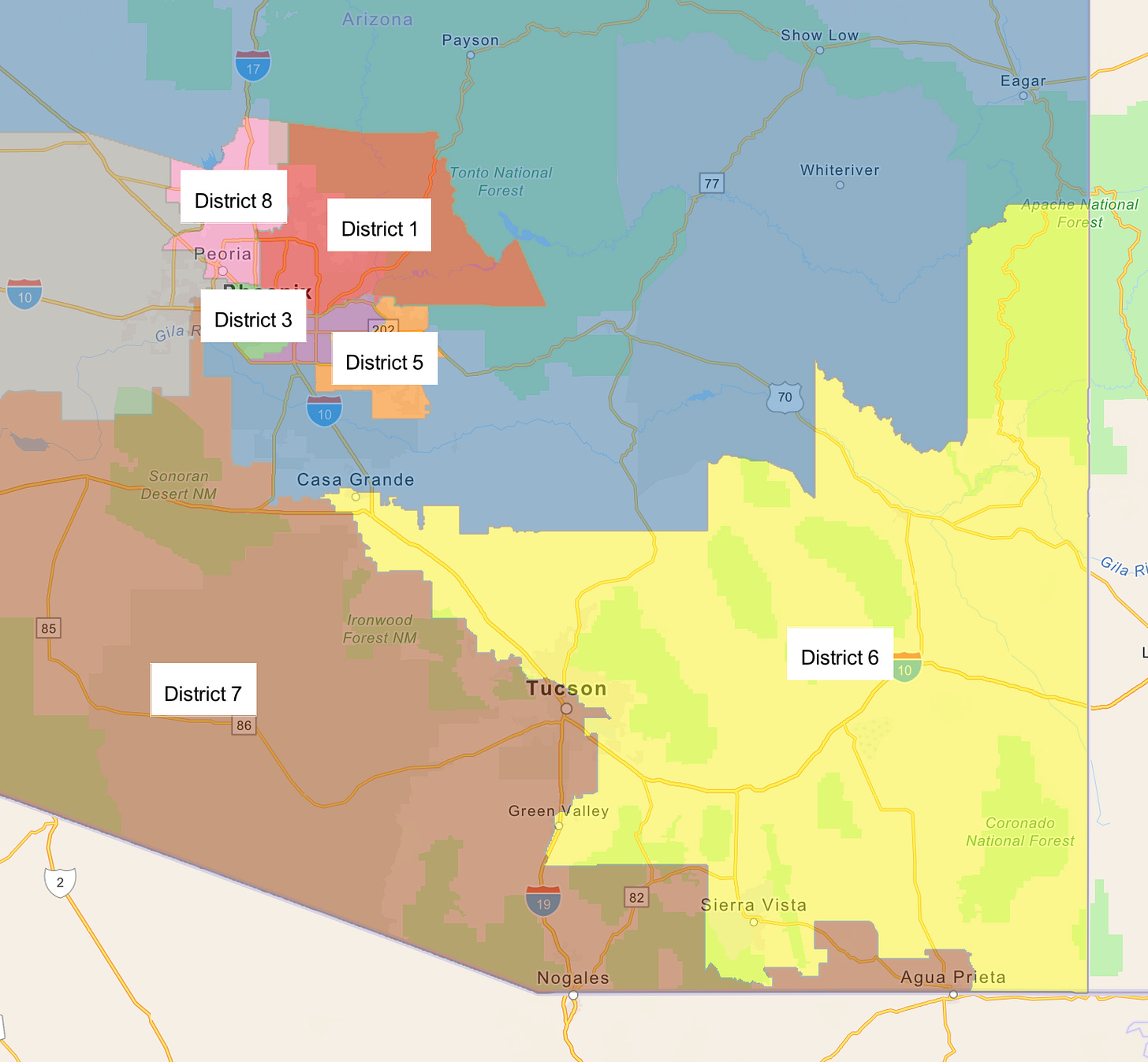The Annual Agenda: What a difference a year makes
A year after our launch, we’re still focused on local government … But we’re also working on so much more … Iron River flows from Pima County to Mexico.
Tomorrow marks one year since we launched the Tucson Agenda and we can’t believe how quickly 365 days flew by. As we look back on this amazing year filled with firsts for both Caitlin and Curt, the big question that came to mind is, did we accomplish what we set out to do?
The short answer is yes, and we had some pretty high expectations, so that’s no small feat. But a lot has happened in the last year, so let’s take a minute and talk about what we set out to do when we launched.
Our goal was to fill in the gaps in local reporting and provide rigorous coverage of local government, politics and the organizations that provide necessary services to Southern Arizona residents.
We also wanted to lean into local elections and make sure we provided our readers with as much information as possible about the people and initiatives on their ballots. And since we know election season is pretty much year-round, we wanted to start dropping that coverage way before ballots hit mailboxes.
This might not sound like the most exciting type of news coverage, but it’s some of the most important, and we knew from our experience as reporters that Tucsonans had an unmet appetite for it.
This is what we wrote way back in May 2023:
“We’ll focus on the bread and butter of local news: local government decisions, politics and government-adjacent issues and organizations. The decisions made by local elected officials have a major impact on our day-to-day lives. We’ll keep a watchful eye on our cities and counties to ensure you know how – and why –those decisions are made. We think you deserve an informative and entertaining way to stay in the know about what’s happening in your community. So, we’re gonna create it!”
Looking back on the past year, it’s clear we’ve done what we planned and told our readers we were going to do. That’s not to say we were perfect. We’re the first to admit that we’ve stumbled here and there, like anybody would when they take on a big, new endeavor.
But we set high standards for ourselves and every day we worked hard to meet them. Luckily, we didn’t have to go it alone.
When we started, one of our main goals was to tell people what the deal was. No muss, no fuss. And that’s what we’ll keep doing in the coming year.
Since our launch, we’ve had the support and keen eye of former Arizona Daily Star Executive Editor Jill Jorden Spitz, who has been invaluable in providing advice, insights and editing assistance. And Hank Stephenson at our sister newsletter, the Arizona Agenda, is the mastermind behind the whole Agendaverse and has been a wizard at helping us navigate the newsletter scene.
With the help of our student interns and contributors (we’ve provided opportunities to eight, so far), we’ve published more than 250 original articles. We also curated 1,500 news stories from other local outlets.
And we’re writing about topics that matter. We’re covering local elections ad nauseam and laid out our coverage plan back in March. We’ve interviewed nearly all the local candidates running in competitive races, kept tabs on campaign finance (the next report drops in two weeks) and built an election wiki to help voters easily access the information they need. And we aren’t just focusing on the big races, we’re also covering town councils and the down-ballot races that can have a big impact in the community.
One of our other goals was to increase coverage for and about the Hispanic community, which we’ve done by hiring Susan Barnett to cover South Tucson and issues and elections that impact Hispanic voters.
We’ve been right there covering the University of Arizona financial crisis, but we’ve also written about topics that no one else is covering. We’ve said from the start that there aren’t enough reporters to cover all the news in Southern Arizona, and the past year has made it even clearer how true that is.
We rebranded our solutions-focused stories as “The Solutions Agenda” in October to help readers easily identify stories about people and groups working to improve the lives of others. And in February we launched our bi-weekly “Climate Agenda” in response to readers’ desire for regular reporting on climate news.
We started writing briefs to keep readers in tune with what their local elected officials are doing from week to week. And not just the city and county: We’ve also been providing regular coverage of Marana, Oro Valley, and local school boards.
“Excellent concise summaries of noteworthy things local residents need to know!” as one Agenda reader put it.
We’ve also taken steps to be more than just a newsletter, forming partnerships with people and groups to help provide education and foster a sense of community.
We teamed up with Becky Pallack of the Arizona Luminaria last fall to put on an information session about the city elections for members of Tucson Young Professionals. Curt has moderated debates for the Democrats of Greater Tucson and the Citizens Clean Elections Commission and Caitlin created a primary election guide for the LGBTQ Chamber of Commerce to share with its members.
The book club Caitlin started last year with the Community Foundation for Southern Arizona and Tucson Tome Gnome is still going strong, with the eighth meeting happening in just a few weeks. Next week, Caitlin will be in Minneapolis with a few dozen other journalism industry leaders learning about other opportunities for community collaboration.

In short, we did all the things the public expects from a local news outlet and then some, since the ability to innovate is one of the most exciting things about launching your own product.
We think we’ve played an important role this past year in helping to reinvigorate the local news scene, and it seems like funders agree. We have received $85,000 in funding through two separate grants to help increase our reporting and we’re hopeful that these are the first of many.
But we wouldn’t have even been able to apply for any grants were it not for the more than 700 of you who decided a paid subscription to the Agenda was a good use of your hard-earned money.
It’s been a lot of work but even more fun, and we’re proud of the impact we’ve had on the community.
And, of course, we don’t plan to stop any time soon.
Iron River: More than 2,000 firearms recovered at crime scenes in Mexico and Central America came from gun stores in Pima County, the Tucson Sentinel’s Paul Ingram reports. That tally was compiled from federal records by the nonprofit Stop US Arms to Mexico. Nearly 9,500 firearms came from Arizona and more than twice that amount were from Texas.
Still in the dark: Two years after Arizona voters said they wanted to know who was behind the dark money flowing into politics, they are still in the dark, Arizona Republic columnist Laurie Roberts writes. The Voters Right to Know Act got support from nearly 75% of voters, but so far the Arizona Secretary of State’s Office hasn’t posted reports from any dark money on its “dud of a campaign finance website,” Roberts writes.
Border top of mind: KGUN’s Craig Smith sat down with the two Republican candidates running for the seat in Congressional District 6. Challenger Kathleen Winn pointed to her experience setting up homeless shelters and fighting sex trafficking. Her top priority is securing the border, followed by the economy, such as helping families deal higher prices.
Ciscomani’s view: Incumbent Rep. Juan Ciscomani told Smith he sees the border as three separate issues that get mashed together in Washington, D.C.: Immigrants who work hard and could benefit from a guest worker program; billions of dollars worth of commerce; and cartels that smuggle people and drugs. Ciscomani also talked about foreign policy issues, such as conflicts in Ukraine, Israel-Hamas, and aid for Taiwan.
Solar dollars: The federal government is providing $55 million in loans to support electric cooperatives in Arizona, including Trico in Pima County, the Arizona Daily Star’s David Wichner reports. The money will support three battery energy-storage projects, including one in Sahuarita where officials held a ribbon-cutting ceremony Tuesday morning.
“These co-ops have made all these investments in solar energy, and that energy has been stored up and with these batteries now, they can release it back into the grid,” said Andy Berke, administrator of the USDA’s Rural Utilities Service.
New focus: The group that has led local efforts to support asylum seekers is refocusing its efforts, KVOA’s Zachary Jackson reports. Catholic Community Services said it will focus on helping women and families with children at a shelter in Ajo, opening the door for other groups or agencies to take on a larger role in the general effort to support asylum seekers in Southern Arizona.
4: The total inches of rain some areas in Southern Arizona got in June. The National Weather Service says this June was wetter than usual.











An early Happy Birthday to you and your valuable service. Used to be a regular at the Shanty (careful with that ATM) so, I know ya'll will have a good time. Cheers!
Congratulations, Curt and Caitlin! is it only one year? Reading the Tucson Agenda every day has provided me with so much news and information, I could swear you have been at this longer, like maybe two or three years. All my best wishes that your subscribers list grows rapidly. That is important to the survival of the Tucson Agenda and the quality of life in Tucson and Southern Arizona.